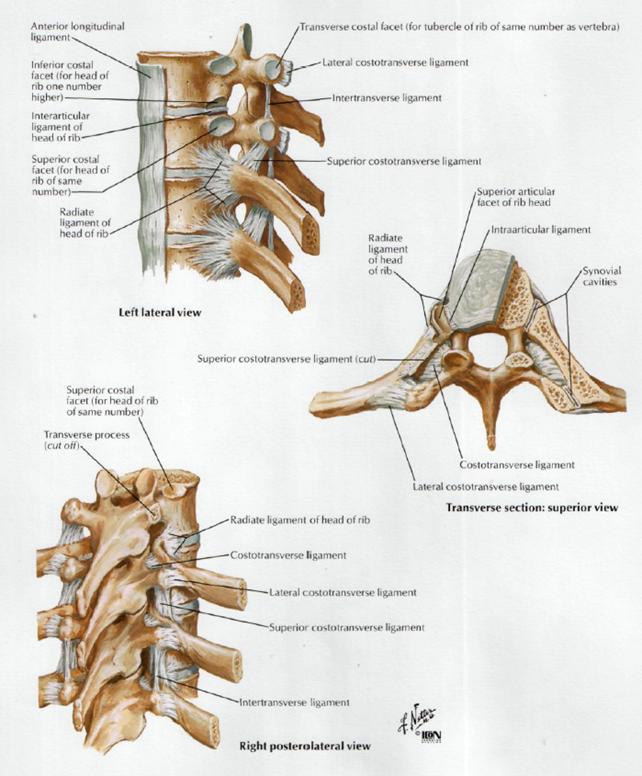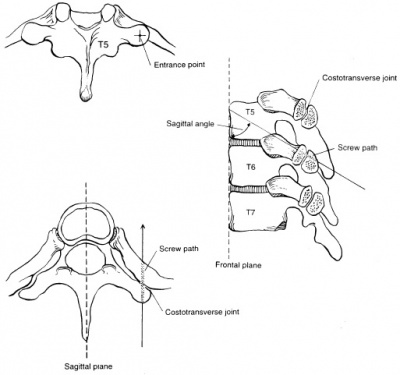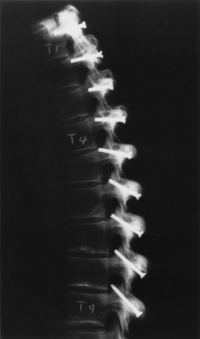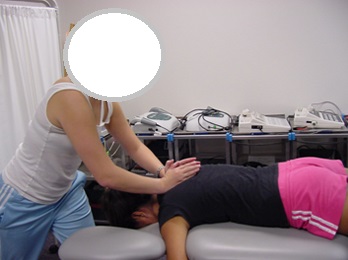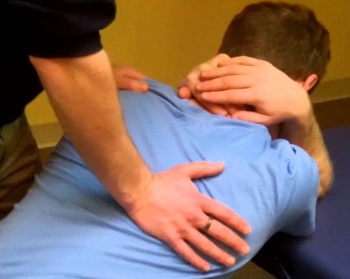Costotransverse Disorders
Original Editors - Yves Hubar
Top Contributors - Yves Hubar, Lisa De Donder, Scott Cornish, Simisola Ajeyalemi, Admin, Kim Jackson, Rachael Lowe, Maëlle Cormond, WikiSysop, Vidya Acharya, Chelsea Mclene, Evan Thomas, Claire Knott, 127.0.0.1 and Laura Ritchie
Search Strategy[edit | edit source]
Searched databases: Pubmed, PEDRo, ScienceDirect, spine journal
Keywords: costotransverse joint, differential diagnosis, costovertebral, thoracic pain, physical examination.
Searching for the term "costotransverse" yielded few results, but searching for conditions affecting the costovertebral joints in general supplied more information.
It is to be noted that most of the information found are case studies.
Definition/Description[edit | edit source]
The costotransverse disorders are disorders affecting or involving the costotransverse and costovertebral joints and ligaments.[1](LOE: 2C)
It is suggested that dysfunctions in these joints could account for pain in the thorax or functional impairments, as described below. [1](LOE: 2C) [2] (LOE 4) [3] (LOE 3B)
Clinically Relevant Anatomy[edit | edit source]
Articulations There are two joints that form the connection between the rib and the vertebra, namely the costotransverse and the costovertebral joint.[4] (LOE 1A) The costotransverse joint is an articulation between the articular tuberculum costae of the rib and the costal facet of the transverse process of a thoracic vertebra.[5] (LOE 1A) [3] (LOE 3B) [4] (LOE 1A) The costovertebral joint is the articulation between the costal fovea or demifacets (formed by the caudal side of the superior vertebra and the cranial side of the inferior vertebra) and the caput costae.[3] (LOE 3B) [4] (LOE 1A)
Together with the thoracic cage, the costovertebral and costotransverse joints provides stability.[3] (LOE 3B)
Ligaments
The following costotransverse and costovertebral ligaments connect the two joints[6]:
- ligamentum costotransversarium superius.
- ligamentum costotransversarium.
- ligamentum costotransversarium laterale.
- ligamentum capitis costae radiatum
- inferior costotransverse ligaments[7] (LOE: 2C)
- posterior costotransverse ligaments, identified on the fifth to tenth ribs [7](LOE 2C)
These ligaments limit movement in the costotransverse joint to slight gliding.
Figure 1: The ligaments connecting the ribs and vertebra[8]
Epidemiology /Etiology[edit | edit source]
- It is more common in women [2] (LOE 4) [9] (LOE 3B) and can occur at any age 27 LOE 3B)
- When subjected to severe trauma, these joints can subluxate or dislocate. Due to being at the top of the rib cage, the first costotransverse joint is the most vulnerable.[10] (LOE 4)
- Though distinctly unusual at the costotransverse and costovertebral joint, rheumatoid artritis can occur in said joints.[11] (LOE 4)
- The involvement of dysfunction at these joints are a source of referred pain at the thoracic spine, with suggested involvement of the costotransverse joint concerning T4 syndrome[1] (LOE 2C)
- The costotransverse joint is known to be involved in patients with ankylosing spondylitis, which, combined with involvement of the costovertebral, sternoclavicular and sternomanubrial joints, would result in increased rigidity of the thorax and increased dorsal kyphosis. This does not result in decreased pulmonary function, which is possibly due to an increase in diaphragmatic breathing [12] (LOE 2B)
- Due to positive response to manual therapy directed towards posterior spinal structures, conditions diagnosed as costochondritis might actually be caused by neurogenic inflammation.[13] (LOE 4) [2] (LOE 4)
Characteristics/Clinical Presentation[edit | edit source]
Possible symptoms are:
- Pain localized to the posterior thorax[14] (LOE 3B)
- Pain may radiate to the anterior chest wall [14](LOE 3B)
- Unilateral symptoms [14](LOE 3B)
- Pain with deep breathing, coughing/sneezing [14](LOE 3B) [3] (LOE 3B)
- Increased pain with flexion, rotation and ipsilateral side bending [14](LOE 3B)
- Palpable pain at costotransverse joint and rib angle [14](LOE 3B)
- Neck pain, head ache or both [3](LOE 3B)
- The sensation of having a useless or heavy limb [3](LOE 3B)
- Referred pain originating from under the scapula and worsen with coughing, sneezing or deep breathing [3](LOE 3B)
- Acute, atypical chest pain [3](LOE 3B) [9] (LOE 3B)
Differential Diagnosis
[edit | edit source]
Differential diagnostic possibilities have to be taken into consideration in case of posterior upper thoracic and/or scapular pain and possible involvement of costovertebral and costotransverse joints [14] (LOE: 3B) )[15] (LOE: 1A):
Possible musculoskeletal sources of thoracic pain [14] (LOE: 3B) [16] (LOE: 1A):
- Muscle strain (m. erector spinae, lower and middle trapezius, mm. rhomboideus, m. latissimus dorsi, m. levator scapulae and intercostal muscles)
- Vertebral or rib fracture
- Zygapophyseal joint arthropathy
- Active trigger points
- Spinal stenosis
- Intervertebral disc protrusion or herniation
- Diffuse idiopathic skeletal hyperostosis (DISH)
- Intercostal neuralgia
> often follows injury or thoracic surgery;
> focal tenderness over affected intercostal area;
> burning pain and paresthesias in thorax or abdomen that usually follow the nerve path [17] (LOE: 2B).
- T4 syndrome
- Ankylosing spondylitis
- Costovertebral and costotransverse joint dysfunction
Possible visceral sources of thoracic pain [14] (LOE: 3B) [16] (LOE: 1A):
- Cancer
- Cardiac conditions
> substernal pain;
> shortness of breath;
> increased pain with exertion;
> frequent left shoulder, medial arm and jaw pain [18] (LOE: 1A).
- Renal conditions
> referred pain to the ipsilateral subcostal and costovertebral regions at T10-T12;
> typically dull and aching pain;
> possible changes in urinary frequency or output [16] (LOE: 1A).
- Pulmonary conditions
- Gastroesophageal conditions
> band-like pain around mid-thorax at level of lesion;
> referred pain to the mid thoracic area;
> nausea/vomiting;
> weight loss, heartburn or substernal pain;
> stabbing or burning chest pain [19] (LOE: 1A).
- Gall bladder conditions
> pain in the right mid-epigastric region (T8-T9 level);
> referred pain at the mid-back between the scapulae, right upper trapezius muscle and right subscapular area;
> jaundice;
> fever;
> chills;
> indigestion;
> nausea/vomiting;
> intolerance of fatty foods [20] (LOE: 1A).
- Hepatobiliary conditions ->
> pain in the right upper abdomen quadrant;
> referred pain at right interscapular and subscapular areas;
> right shoulder pain;
> anorexia;
> nausea;
> vomiting;
> jaundice;
>ascites;
>significant fatigue [20] (LOE: 1A).
Diagnostic Procedures[edit | edit source]
Clinical findings and patient presentation are used to diagnose costovertebral and costotransverse joint dysfunction [21] (LOE: 3B) [22] (LOE: 3B). This is done through a thorough anamnesis and clinical examination [21](LOE: 3B) [22] (LOE: 3B).
Outcome Measures[edit | edit source]
Pain is measured with a numeric pain scale (for example VAS), while function is measured with the Dallas Pain Questionnaire and Functional Rating Index. [9] [9] (LOE: 3B)
Examination[edit | edit source]
The physical examination consists of the following components:
- Inspection of the posterior, lateral and anterior sides of the trunk, to check for deviations from an ideal posture (standing) [14](LOE: 3B)
- Active range of motion of the cervical (seated), trunk (standing) and shoulder regions (seated) to determine pain-provoking movements [14] (LOE: 3B) [24] (LOE: 1A)
| [25] | [26] |
- Manual muscle testing to assess upper extremities strength and intensity of possible elicited pain (seated) [28] (LOE: 3A) -> http://www.physio-pedia.com/Muscle_Strength
- Sensory examination of the upper extremities and thoracic area , in order to determine whether nerve root or peripheral nerve lesions are present [14] (LOE: 3B)
- Joint play of the thoracic spine (prone) to check for pain and mobility [30] (LOE: 2B) [31] (LOE: 2A)
- Posterior (prone) and anterior (supine) costosternal joint play to check for pain and mobility [30] (LOE: 2B) [31] (LOE: 2A)
- Active and passive scapular mobility in case of reduced active shoulder range of motion and/or pain of the scapula region [24](LOE: 1A)
- Palpation of the cervical, upper trunk and shoulder regions to check for soreness or pain (10) (LOE: 3B) (18) (LOE: 1A)
| [33] | [34] |
Medical Management
[edit | edit source]
In an unstable thoracic spine (caused by trauma, degenerative conditions, tumors and deformities) posterior instrumentation and fusion are commonly used as treatment. Numerous techniques have been reported to restore spinal stability and correct spinal deformities. Posterior fixation of the thoracic spine through the costotransverse joint may be an alternative (figure 2).
Thanapipatsiri and Chan (1996) [35] (LOE: 4) showed that posterior thoracic fixation through the transverse processes is safe because implants placed beneath the transverse processes are away from the parietal pleura and the intercostal vessels and nerves. Heller et al. (1999) demonstrated that transverse process screws were weaker biomechanically than pedicle screws in the upper thoracic spine, but safer technically [36] (LOE: 4). Fixation around the transverse processes in the thoracic spine seems to be simple and safe, but fixation through the costotransverse joint may be more rigid than through the transverse process.
Risks of costotransverse screw fixation:
- Injury of the intercostal neurovascular structures.
- Injury of the parietal pleura.
- Fixation at multiple levels may result in limitation of movement of the thoracic cage and may affect the long function.
[37] (LOE: 4)
Figure 2: Illustration of posterior costotransverse screw insertion technique. [37] (LOE: 4).
Physical Therapy Management
[edit | edit source]
Mobilization:
Rotational glide ribmobilisation and distraction techniques.
- Mobilisation of the rib is done in the anteroposterior direction, using oscillations with contact on the dorsal surface of the rib, adjacent to the thoracic spinal articulation [9] (LOE: 3B) (figure 3). Rib distraction mobilizations can be a good first attempt to treat a rib dysfunction. This technique is best done when the patient is sitting or lying down.
Figure 3 [9]
- A rib rotational glide is an effective technique and sometimes preferable to the rib distraction technique if direct pressure on the rib is too painful. This technique can be administered while the patient in standing, sitting, or in reclining position (figure 4)
Figure 4 [38]
According to Maitlandetal (2005), mobilizations can be used in 2 basic circumstances:
- Treatment of stiffness [38] (LOE: 1B).
- Treatment of pain, rather than stiffness.
3 repetitions should be performed, followed by retesting for pain on palpation, and be repeated the mobilization to any rib that was still painful, until there is no longer palpable pain [38] (LOE: 1B).
General spinal mobilizations [3] (LOE: 3B).
Elbow mobilizations [3] (LOE: 3B).
Other hands-on techniques:
- Dorsal glides of the thoracic spinal facet joints (via the ribcage) [3] (LOE: 3B).
- Soft tissue techniques: massage (deep friction, friction and normal), stretching and trigger point release) [3] (LOE: 3B).
- Massage of the scalene muscles [3] (LOE: 3B).
- Lasertherapy of the ribs [3] (LOE: 3B).
- Acupuncture (contra-indications) [3] (LOE 3B) [9](LOE: 3B).
- High velocity, low amplitude chiropractic diversified adjustments in a anteroposterior direction with the patient in a supine position [9] (LOE: 3B).
- High-velocity, low amplitude manipulations directed at the costovertebral, costotransverse and intervertebral zygapophyseal thoracic joints [2] (LOE: 4)
- Mobilizations of the costovertebral and costosternal joints: large amplitude P/A oscillations of the ribs in prone position [14]. (LOE: 3B)
Exercise therapy:
- Chest lifts as a home exercise [3] (LOE: 3B).
Chest lifts may be a useful generic treatment technique for a rib articular dysfunction or thoracic facet joint dysfunction. With the patient in hand and knee position, reach underneath its chest with both hands, lace fingers together, and slowly and gently lift the torso.
Repeat this maneuver a few times, slowly and rhythmically, lifting from different portions of the chest or sternum to create a movement at different segments of the thoracic spine. The techniques should be pain free.
- Underwater treadmill therapy [3] (LOE: 3B).
- Push-ups to activate the pectoral musculature (after 6th visit). 5 to 10 repetitions, 3 sets [9] (LOE: 3B).
- Wall push ups (after 7th visit), progressively build up to full push ups and plusses. 5 to 10 repetitions, 3 sets [9] (LOE: 3B).
Patients are instructed to use ice according to the following protocol: ice pack wrapped in a light towel, applied over the sternum for ten minutes, followed immediately by a twenty minute rest period. Repeat this cycle four times consecutively, daily for the first ten days of treatment [9] (LOE: 3).
Key Research[edit | edit source]
add links and reviews of high quality evidence here (case studies should be added on new pages using the case study template)
Resources
[edit | edit source]
add appropriate resources here
Clinical Bottom Line[edit | edit source]
add text here
Recent Related Research (from Pubmed)[edit | edit source]
see tutorial on Adding PubMed Feed
Failed to load RSS feed from http://eutils.ncbi.nlm.nih.gov/entrez/eutils/erss.cgi?rss_guid=1d9iTY4hH_PwaIrU17P6I8p8R_Zd-yLCVj7ZeM06XUyfhqvEwH!!|charset=UTF-8|short|max=10: Error parsing XML for RSS
References[edit | edit source]
see adding references tutorial.
- ↑ 1.0 1.1 1.2 B A Young, H E Gill, R S Wainner, T W Flynn. Thoracic costotransverse joint pain patterns: a study in normal volunteers. BMC Musculoskelet disord. 2008; 9: 140 (level of evidence 2C)
- ↑ 2.0 2.1 2.2 2.3 D Aspegren, T Hyde, M Miller. Conservative treatment of a female collegiate volleybal player with costochondritis. Journal of manipulative and physiological therapeutics (2007) 30(4): 321-325 (level of evidence 4)
- ↑ 3.00 3.01 3.02 3.03 3.04 3.05 3.06 3.07 3.08 3.09 3.10 3.11 3.12 3.13 3.14 3.15 3.16 3.17 Edge-Hughes, L. (2014). Canine Thoracic Costovertebral and Costotransverse Joints: Three Case Reports of Dysfunction and Manual Therapy Guidelines for Assessment and Treatment of These Structures. Topics in Compan An Med, 29, 1–5. (Level of evidence: 3B)
- ↑ 4.0 4.1 4.2 M. Shünke, E. Schulte, U. Schumacher, J. Rude, M. Voll, K. Wesker(eds.): Algemene anatomie en bewegingsapparaat. Houten: Bohn Stafleu van Loghum 2010. (2nd edition) ISBN: 978-90-313-79347
- ↑ Neumann DA. Kinesiology of the Musculoskeletal System: Foundations for Physical Rehabilitation. St. Louis: Mosby 2002. ISBN: 978-0-8151-6349-7
- ↑ Agur A.M.R., Lee M.J. Grant's Atlas of Anatomy. Lippincott Williams & Wilkins 1999 (10th ed.) ISBN: 978-0683302646
- ↑ 7.0 7.1 A F Ibrahim, H H Darwish. The costotransverse ligaments in human: a detailed anatomical study. Clinical Anatomy 18:340-345 (2008) (Level of evidence 2C)
- ↑ 37. Kafedra (2013) [photo] Сполучення хребців між собою та з черепом. Сполучення кісток черепа: шви, зв’язки, синхондрози, скронево-нижньощелепний суглоб.. Consulted on June 1, 2015 on http://intranet.tdmu.edu.ua/data/kafedra/internal/anatomy/classes_stud/uk/med/lik/ntn/2/04%20%D0%A1%D0%BF%D0%BE%D0%BB%D1%83%D1%87%D0%B5%D0%BD%D0%BD%D1%8F%20%D1%85%D1%80%D0%B5%D0%B1%D1%86%D1%96%D0%B2%20%D0%BC%D1%96%D0%B6%20%D1%81%D0%BE%D0%B1%D0%BE%D1%8E%20%D1%82%D0%B0%20%D0%B7%20%D1%87%D0%B5%D1%80%D0%B5%D0%BF%D0%BE%D0%BC..files/image017.jpg
- ↑ 9.0 9.1 9.2 9.3 9.4 9.5 9.6 9.7 9.8 9.9 Hudes, K. (2008). Low-tech rehabilitation and management of a 64 year old male patient with acute idiopathic onset of costochondritis. Family Chiropractic & Rehabilitation, 52 (4), 224-228. (Level of evidence: 3B)
- ↑ Christensen EE, Dietz GW. Injuries of the costovertebral articulation. Radiology 1980. Jan; 134(1): 41-3 level C
- ↑ MJ Cohen, J Ezekiel, RH Persellin. Costovertebral and costotransverse joint involvement in rheumatoid artritis. Ann Rheum Dis 1978 October; 37(5): 473-475 (level of evidence 4)
- ↑ L Cerrahoglu, Z Unlu, M can, C Goktan, P Celik. Lumbar stuffness but not thoracic radiographic changes relate to alteration of lung function tests in ankylosing spondylitis. Clin Rheumatol (2002) 21(4):275-279 (level of evidence 2B)
- ↑ M I Rabey. Costochondritis: are the symptoms and signs due to neurogenic inflammation. Two cases that responded to manual therapy directed towards posterior spinal structures. Manual therapy (2008) 13(1): 82-86 (level of evidence 4)
- ↑ 14.00 14.01 14.02 14.03 14.04 14.05 14.06 14.07 14.08 14.09 14.10 14.11 14.12 S J Fruth. Differential diagnosis and treatment in a patient with posterior upper thoracic pain. Physical therapy (2006) 86(2): 254-268 level C –(LOE: 3B)
- ↑ Cite error: Invalid
<ref>tag; no text was provided for refs namedA - ↑ 16.0 16.1 16.2 McConaghy JR, Oza RS. Outpatient diagnosis of acute chest pain in adults. Am Fam Physician (2013) Feb 1;87(3):177-82. (LOE: 1A)
- ↑ Williams EH et al. Neurectomy for treatment of intercostal neuralgia. Ann Thorac Surg (2008) May;85(5):1766-70. (LOE: 2B)
- ↑ Haasenritter J et al. Does the patient with chest pain have a coronary heart disease? Diagnostic value of single symptoms and signs – a meta-analysis. Croat Med J (2012) Oct;53(5):432-41. (LOE: 1A)
- ↑ Spiegel BM et al. Development of the NIH Patient-Reported Outcomes Measurement Information System (PROMIS) gastrointestinal symptom scales. Am J Gastroenterol (2014) Nov;109(11):1804-14. (LOE: 1A)
- ↑ 20.0 20.1 Duncan CB, Riall TS. Evidence-based current surgical practice: calculous gallbladder disease. J Gastrointest Surg (2012) Nov;16(11):2011-25.
- ↑ 21.0 21.1 Scaringe JG, Ketner C. Manual methods for the treatment of rib dysfunctions and associated functional lesions. Topics in Clinical Chiropractic. (1999);6:20-38. (LOE: 3B)
- ↑ 22.0 22.1 Triano JJ et al. Costoverebral and costotransverse joint pain: a commonly overlooked pain generator. Topics in Clinical Chiropractic. (1999);6:79-92. (LOE: 3B)
- ↑ Youtube (2012). Macleod’s examination of the thoracic and lumbar spine. Consulted on May 28, 2014 on https://www.youtube.com/watch?feature=player_detailpage&v=3UhKFcR1Wbs
- ↑ 24.0 24.1 Huygen F et al. Painful shoulder complaints. Pain Pract. (2010) Jul-Aug;10(4):318-26. (LOE: 1A)
- ↑ Youtube (2009). Range of Motion Test – Cervical ROM. Consulted on May 28, 2014 on https://www.youtube.com/watch?v=PrbmBMehYx0
- ↑ Youtube (2012). Range of Motion Test – Thoracic ROM. Consulted on May 28, 2014 on https://www.youtube.com/watch?v=_u0fPi2XBls
- ↑ Youtube (2009). Shoulder Exam (3 of 9): Range of motion. Consulted on May 28, 2014 on https://www.youtube.com/watch?v=d7HfaAlgaro
- ↑ Hislop HJ, Avers D, Brown M. Daniels and Worthingham’s Muscle Testing: Techniques of Manual Examination and Performance Testing. 9th Edition, Pa: WB Saunders Co; (2014) (LOE: 3A)
- ↑ Youtube (2012). Macleod’s examination of the upper limbs sensation. Consulted on May 28, 2014 on https://www.youtube.com/watch?feature=player_detailpage&v=wSSCZeOKXBE
- ↑ 30.0 30.1 Hicks GE et al. Interrater reliability of clinical examination measures for identification of lumbar segmental instability. Arch Phys Med Rehabil. (2003);84:1858-1864 (LOE: 2B)
- ↑ 31.0 31.1 Seffinger MA et al. Reliability of spinal palpation for diagnosis of back and neck pain: a systematic review of the literature. Spine. (2004);29:E413-425 (LOE: 2A)
- ↑ Youtube (2009). Shoulder Exam (4 of 9): Scapular control (Is there scapular dyskinesia?). Consulted on May 28, 2014 on https://www.youtube.com/watch?v=pEY93k5XXL0
- ↑ Youtube (2011). Macleod’s Examination of cervical spine (non traumatic). Consulted on May 28, 2014 on https://www.youtube.com/watch?v=qdi3VKA-wJI
- ↑ Youtube (2009). Shoulder Exam (2 of 9): Inspection and Palpation. Consulted on on May 28 on https://www.youtube.com/watch?v=Xf52jbNA7wg
- ↑ Thanapipatsiri S, Chan DPK. Safety of thoracic transverse process fixation: an anatomic study. J Spinal Disorders 1996;9:294–8. (Level of evidence 4)
- ↑ Heller JG, Shuster JK, Hutton A. Pedicle and transverse process screws of the upper thoracic spine. Spine 1999;24:654–8. (Level of evidence: 4)
- ↑ 37.0 37.1 Rongming, X., Nabil, A.E., Yiangjia, O., Martin, S., Richard, A.Y. (2000). Anatomic Considerations of Costotransverse Screw Placement in the Thoracic Spine. Surg Neurol 2000;53:349 –55. (Level of evidence: 4)
- ↑ 38.0 38.1 38.2 Maitland, G., Hengeveld, E., Banks, K., English, K. (2005). Maitland' Vertebral Manipulation. 7th ed. Heinemann, Toronto: Elsevier Butterworth. (Level of evidence: 1B)
To summarize: all sources from #3 are non comparative studies, therefore level C is applicaple.
